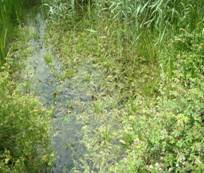Flora
The canal is particularly rich in marginal vegetation, these are the plants found alongside the banks but growing in the water.
The tall narrow leaved plants dominate with the bright green leaves of Branched Bur-reed, the rippling flower heads of Common Reed, and the blue green leaves and dark brown flower head of Greater Reedmace being in abundance. Stands of common reed are particularly important for Reed and Sedge Warblers, and all the emergent vegetation provides the habitat for dragonflies and damselflies to emerge from their nymph state to adulthood.

Reeds, rushes and flowering rush
Locally dominant plants are Reed Sweet Grass and Yellow Iris with its beautiful and distinct bright yellow flowers. Flowering Rush has a very pretty multi stemmed flower head supporting small pink flowers, and this is found occasionally along the canal.
Water Soldier, a plant resembling a pineapple top, has a stronghold within the SSSI, but it is not a plant it was notified for. Lesser Reedmace is found occasionally, this is a small version of the species mentioned earlier and has a rusty coloured flower spike. Water Mint, Gypsywort, Arrowhead, Water Plantain and various species of sedge and rush are found at several places alongside the canal.

Water Soldier
Under the water Rigid Hornwort dominates; this is found in extensive masses in shady areas and as its name implies the whorled leaves are stiff to the touch. It is often growing in close proximity to Nuttall’s waterweed. Also dominant is Common Duckweed, a floating small leaved plant that can often look like a grass lawn covering the entire surface of the water. These plants are dominant particularly downstream of Cotgrave.
Between Redmile and Woolsthorpe more diverse plant communities exist including Fan-leaved Water Crowfoot, and many of the Pondweeds (broad-leaved, fennel, perfoliate and curled). The rare Grasswrack Pondweed is present between Redmile and Muston. This species is of national importance and is found primarily in backwaters and slow flowing waters. It has been lost from most river systems and canals have become the refuges for the plant. The population in the canal, therefore, is of national importance.
In some shaded areas the delicate Water Starworts are found, with their star shaped whorl of leaves.
Along the towpath a myriad of wildflowers can be seen in spring and summer. Walkers can see the white flowers of Feverfew, Gypsywort, Meadowsweet and the often found Oxeye Daisy contrasted against the pinks and purples of Burdock, and Cranesbill. Tall plants such as Rosebay Willowherb, Hogweed and Foxglove form the backdrop for the more delicate Speedwell and Pansy. In Spring Celandine will be seen before the summer plants come into flower, and these include the wonderful sunny yellows of Buttercup, Coltsfoot, Lesser Trefoil, Yellow Rattle and Bristly Ox-Tongue. These are only some of the many species of flowering plant found along the canal banks and towpath.
There are two invasive alien plants found in the canal; Water Hyacinth has bright green waxy leaves and a pretty purple flower, but can be very invasive if not kept under control. It has been found near Denton.
Water Fern is present occasionally near Woolsthorpe. This plant can remain dormant as spoors on the canal bed and can grow extensively in some years. It is green during the growing season but changes to red later in the year.
